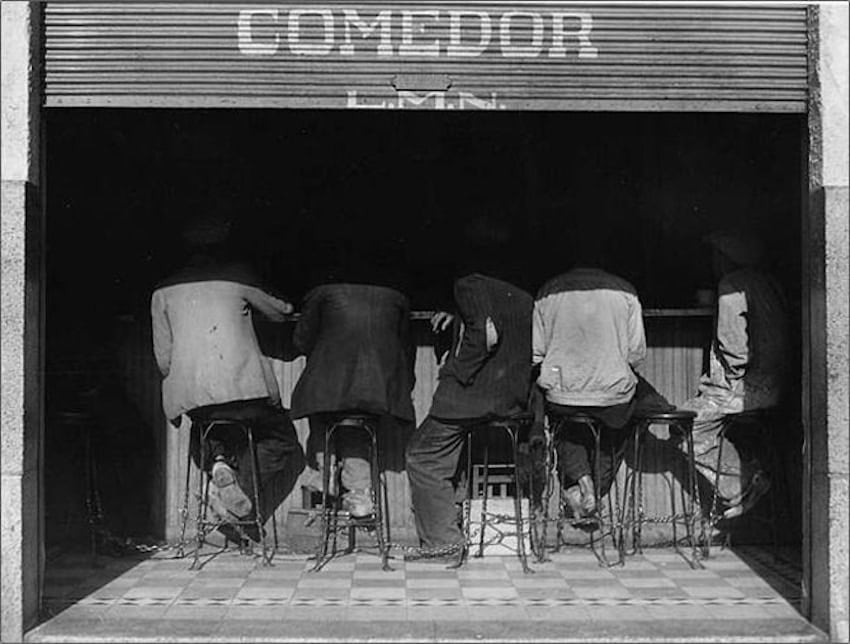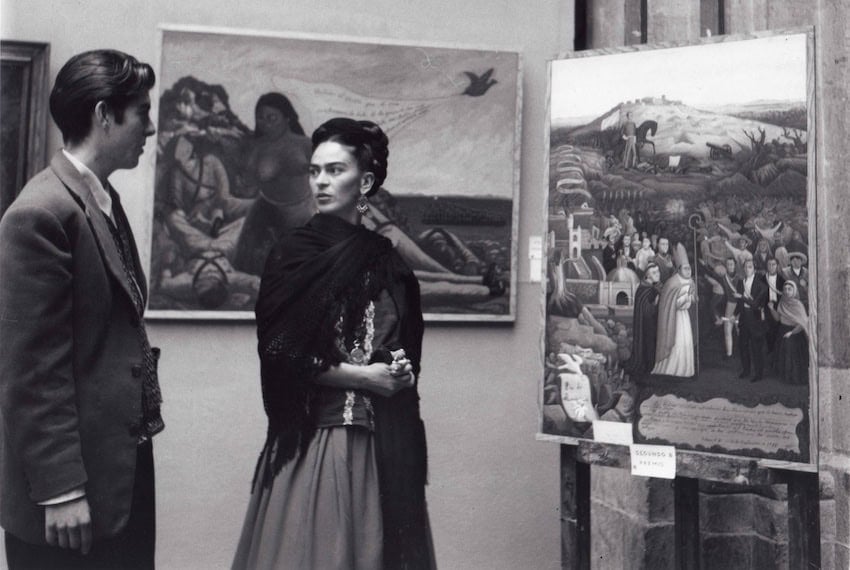At nineteen, I made the decision to become a professional photographer. This wasn’t a romantic whim born from Instagram aesthetics, but something that flourished while studying the work of Mexican and foreign photographers whose lenses transformed the faces, streets, and landscapes of Mexico into masterpieces.
Each photographer held up a different mirror to Mexico. Sometimes it was almost dreamlike and poetic, as in the case of Manuel Álvarez Bravo’s particular gift. Other times, it was violently confrontational, the way Enrique Metinides trained his camera on the city’s margins. Juan Rulfo offered us nostalgia. Tina Modotti and Gabriel Figueroa infused their frames with nationalist fervor and revolutionary spirit. And Lola Álvarez Bravo, the first woman photographer in México, blended art and beauty with documentation and anthropology.

Today, I want to tell you about Lola and Manuel Álvarez Bravo because they were architects of how Mexico would come to understand itself, and their work was intimately bound up with the muralistas and the grand project of constructing a national identity after revolution.
Two lives
The photographs they took together and apart tell the story of a nation in reconstruction, oscillating between the authentically Mexican and the strikingly modern. Their own history reads like cinema — which is fitting, given how much of it remains mysterious. Different sources place their first meeting at different moments: as children, they say, because they were neighbors; or years later, when both were high school students. What matters is that it began.
Manuel Álvarez Bravo was born in Mexico City on February 4, 1902, into a family where art wasn’t a career choice, but as essential as oxygen. His grandfather was a painter; his father was a schoolteacher and amateur photographer. They taught him to see composition before he understood technique, to frame a shot before he held a camera. The camera, a daguerreotype, came as a gift from his best friend’s father, an object that must have felt like magic in the hands of a young man hungry to capture the world.
When his father died, when Manuel was barely twelve, everything shifted. Economic necessity pushed him toward work in a textile factory, then into a position at the National Treasury. But photography never released its hold on him. It lived beneath the surface of his ordinary life, waiting. Later, when he attended the San Carlos Academy, he thought briefly that he might become a painter. He was learning, always learning, waiting for clarity.
Dolores Martínez de Anda, known as Lola, was born in Lagos de Moreno, Jalisco, on April 3, 1903. Her early life held a different kind of luxury — her father was an importer, and the family lived comfortably. But comfort is fragile. Her mother abandoned them and the family moved to Mexico City while Lola was still a child. She lost her father soon after, and her stepbrother, who claimed he couldn’t afford to keep her, sent her to an orphanage.
In 1922, at the National Preparatory School, Lola found what institutions and family had failed to provide: kinship. She met Frida Kahlo and they soon became inseparable. Around the same time, she reconnected with Manuel. What had been childhood familiarity became something else entirely. They married in 1925.
The marriage transformed Lola into a photographer, despite Manuel’s desire. In the darkroom, watching Manuel work, she discovered something she didn’t know she was looking for. While her husband composed his shots with the precision of a trained eye, she found herself drawn to the medium with the intensity of discovery. At the same time, the young couple found themselves at the center of Mexico City’s artistic ferment. They knew the painters, the intellectuals, the people who were consciously building a new Mexico from the wreckage of revolution.
The foreigners who became midwives for Mexican culture
Then came Edward Weston and Tina Modotti. The American and the Italian arrived in Mexico in 1923, intending to stay briefly, instead finding themselves enraptured by the country’s artistic potential. They remained. They worked. They connected with everyone who mattered and were actively imagining what Mexico could become.
Weston eventually returned to the United States in 1927, but Tina Modotti stayed until her political activism became impossible to ignore. In 1930, she was imprisoned on accusations of participating in an assassination attempt against President Pascual Ortiz Rubio and subsequently expelled from Mexico. But in those years, Modotti became something closer to a midwife of the Mexican photographic imagination. She collaborated with Anita Brenner on “Idols Behind Altars,” a landmark text on pre-Hispanic Mexican culture. More immediately, she worked with Mexican Folkways, the cultural journal created by Frances Toor — the Mexico News Daily of the 1920s and 1930s — where anthropologists, archaeologists, architects, artists, and historians gathered to interpret Mexican culture to an international audience.
For Manuel and Lola, Modotti was instrumental to their artistic trajectories. She gave Manuel her position at Mexican Folkways when she left Mexico in 1930. For Lola, she did something more intimate: needing money to survive abroad, Modotti sold her first camera to her younger colleague. A camera purchased under necessity became the tool that would launch a career.

Two different angles
Influenced by the aesthetic sophistication of both Modotti and Weston, Manuel Álvarez Bravo developed his own distinctive vision, one that drew back from explicit politics. This choice haunts his legacy. Critics have argued that by stepping away from the activist dimension of photography, by becoming instead almost a voyeur of Mexican daily life, he retreated from art’s political responsibility. But such criticism misses something essential about his gift.
Manuel gave us two Mexicos. The first is intimate and hidden in the theaters of ordinary life. The other is a poetic view of what Mexico could look like beyond partisan ideology. He didn’t want to lead viewers to conclusions about what Mexico should be; he wanted to portray Mexico’s cultural richness, whether capturing a fleeting moment or constructing a carefully composed visual poem. His photographs became a meditation on Mexican identity without descending into propaganda or stereotype.
Manuel proved that the medium was capable of something beyond documentation, that it could carry aesthetic intention and formal mastery, that a photograph could be a complete work of art in itself. He became one of the founding fathers of artistic photography in the Western hemisphere. His work was recognized by UNESCO in 2017, when his archive of negatives, documents, and photographs was added to the Memory of the World program — an honor befitting the depth of his contribution to global visual culture.
Lola’s path diverged significantly. As Mexico’s first major female photographer, she refused false choices. Where Manuel privileged the poetic and intimate, Lola synthesized the political urgency of Modotti with Manuel’s aesthetic refinement. The result was something distinct: photographs that read as almost ethnographic in their attention to detail and context, yet suffused with a sensitivity, a recognition of dignity in her subjects, that revealed dimensions her husband’s work did not fully explore. She photographed indigenous and peasant populations with what one historian called “empathetic archaeology” — a phrase that captures how she blended documentary rigor with profound compassion.
Lola photographed Mexico’s artistic scene who happened to be friends with, the muralistas, painters, musicians and writers, as casually as we take snaps of our friends. But her career truly accelerated only after their separation. There is a mystery here: she kept Manuel’s surname, though their intimacy seems to have ended. The records suggest they grew distant, almost strangers sharing a name. Perhaps this is why her work could finally flower.

The second act
After the separation in 1934 (though they formally divorce until 1949), Lola became a photographer in the most complete sense, but more than that, she became a cultural force. She directed the photography department of the National Institute of Fine Arts. She organized exhibitions of Mexican art for the national museum. She opened her own gallery — the Gallery of Contemporary Art, known today as “La GAM,” which continues to operate today. In 1953, her gallery presented Frida Kahlo’s only solo exhibition in Mexico during Kahlo’s lifetime, a singular honor that speaks to both women’s importance in Mexican artistic history. She not only participated as an artist but shaped the infrastructure of Mexican culture itself.
While Lola’s photography career ascended, Manuel found refuge in film work, where the act of composing and manipulating images carried no stigma, where the reshaping of reality was understood as art rather than deception. From 1943 to 1959, he worked on film productions, including as a cameraman on Sergey Eisenstein’s “¡Que viva Mexico!.”
Lola often remarked that she was the only woman in a world dominated entirely by men. Rather than intimidating her, this circumstance seemed to embolden her. “In my photographs, there are things about Mexico that no longer exist,” she would later say, speaking about her archive. “If I was fortunate enough to find and capture these images, they can serve later as testimony to how life has passed and transformed.” She received the José Clemente Orozco Prize in 1964 from the State of Jalisco, a recognition of her contributions to photography and her efforts to preserve Mexican culture.
An enduring impact
Her work functions as something like an empathetic archaeology of Mexico itself — of its cities and countryside, its people and their transformations over time. It is careful observation married to profound feeling. Manuel’s photographs, by contrast, capture what Mexicans imagined for themselves: their aspirations, their dreams, their attempts to reconcile tradition with modernity. His aesthetic, both classical and modern, was nourished by the cultural expressions of his native Mexico and influenced by cubism and the possibilities of abstract art.

Together, they created a visual narrative of post-revolutionary Mexico and its ongoing evolution. For amateur photographers like myself, their work remains endlessly instructive — not as something to copy, but as proof that the medium can hold depths we haven’t yet discovered. For Mexican women, Lola did something perhaps more important: she proved that a woman could not only participate in art, which was difficult enough in her era, but that they could direct it, promote it and reshape it according to their own vision. She was a photographer, curator, gallery owner, cultural ambassador,and educator. She worked until 1980, when failing eyesight forced her to stop. She died on July 31, 1993, at the age of ninety.
Manuel lived longer — to one hundred years old, passing away on October 19, 2002. Today his archive, scattered between his foundation and the National Institute of Fine Arts, carries a designation befitting his influence: in 2017, his negatives, documents, and photographs were added to UNESCO’s Memory of the World program. He is recognized as one of the founding fathers of modern photography and considered the greatest representative of twentieth-century Latin American photography.
Why they matter today
Today, when everyone is a photographer with their cellphones, their artwork stands as a reference point for what it means to capture something fleeting — a society strongly rooted in its heritage while rapidly adapting to new circumstances. They taught Mexico to photograph itself with dignity and complexity. They taught the world what a post-revolutionary nation looked like when it paused to truly see itself.
More than that, they demonstrated that photography, in the hands of artists with something to say, could be as essential to nation-building as the muralists’ brushstrokes or the writers’ words. In an age of visual oversaturation, their measured, intentional, deeply human images remind us truly seeing one’s own country, one’s own moment — is not passive. It is an act of love, of witness, of responsibility. And they show us that such seeing, when it is genuine, becomes history.
Maria Meléndez is an influencer with half a degree in journalism
